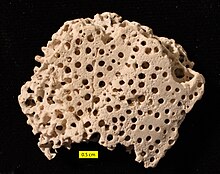Entobia
| Entobia | |
|---|---|

| |
| Modern Entobia borings in an oyster shell | |
| Scientific classification | |
| Kingdom: | |
| Phylum: | Porifera
|
| Class: | Demospongiae
|
| Subclass: | |
| Order: | |
| Family: | |
| Genus: | Entobia Bromley, 1970
|

Entobia and encrusters on a quahog shell, North Carolina.
Entobia is a trace fossil in a hard substrate (typically a shell, rock or hardground made of calcium carbonate) formed by sponges as a branching network of galleries, often with regular enlargements termed chambers. Apertural canals connect the outer surface of the substrate to the chambers and galleries so the sponge can channel water through its tissues for filter feeding (Bromley, 1970). The fossil ranges from the Devonian to the Recent (Taylor and Wilson, 2003; Tapanila, 2006).
References[]
- Bromley, R.G. (1970). "Borings as trace fossils and Entobia cretacea Portlock, as an example". Geological Journal. 3: 49–90.
- Tapanila, L. (2006). "Devonian Entobia borings from Nevada, with a revision of Topsentopsis". Journal of Paleontology. 80 (4): 760–767. doi:10.1666/0022-3360(2006)80[760:DEBFNW]2.0.CO;2.
- Taylor, P.D., Wilson. M.A. (2003). "Palaeoecology and evolution of marine hard substrate communities". Earth-Science Reviews. 62 (1–2): 1–103. Bibcode:2003ESRv...62....1T. doi:10.1016/S0012-8252(02)00131-9.CS1 maint: multiple names: authors list (link)
External links[]

Entobia from the Prairie Bluff Chalk Formation (Maastrichtian, Upper Cretaceous) of Starkville, Mississippi. Preserved as a cast of the excavations.
Categories:
- Boring fossils